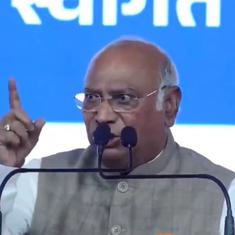Virat Kohli was dismissed for just seven against Bangladesh in the first match of the Asia Cup in February this year. In 13 innings since then, he has crossed 50 on eight occasions, and memorably scored his first-ever Twenty20 century against the Gujarat Lions at Rajkot in the Indian Premier League on Sunday.
Over the last five months, Virat Kohli the batsman has been on a frenzied dash, rewriting one record after another. But Kohli’s game is not just about the records – it's all about the way he is batting at present. From Don Bradman to Sachin Tendulkar, cricket has seen many greats walk the length of its hallowed turf. But what separates Kohli from the others is his inability to fail. All the greats of yesteryear would fail once in a while – their greatness lay in how they recovered from and limited failure. But Kohli remains a freak – he just cannot and does not fail.
Cricket is a game of incredibly thin margins. Things can, and often do, go wrong for no fault of the player. A batsman may hit the perfect shot but also hit it straight at the fielder. A benign pitch may play a random trick and turn an innocuous delivery into a snorter. And of course, an umpire may make a wrong decision and cost the batsman his wicket.
None of these things happen to Kohli. And it is not because he is lucky – it is because he has put himself on a level where nothing seems to affect him anymore.
No settling in
Cricket watchers often wax lyrical about the time-tested theory of batsmen settling in at the crease. Contemporary wisdom suggests that every batsman should give themselves a little bit of time to get comfortable at the start of their innings. This time is used to acclimatise and assess the situation, understand the vagaries of the surface, sum up what the bowler is doing, and then react accordingly.
Kohli both defies that wisdom and obeys it. The difference is that he approaches the settling-in process differently. Whereas other batsmen would prefer to pat their first few deliveries away, Kohli assesses the situation, but at the same time ensures the bowlers do not get a chance to build a rhythm. He may not play the most extravagant shots at the start of his innings, but he ensures that he gets the same number of runs, mainly by running hard between the wickets and ensuring that the run flow never stops.
It may have something to do with his approach to the game, but from the first ball onward, Kohli remains switched on. There is no playing and missing, no half-hearted dabs or indecision. There is only a fierce determination with the confidence of a man who knows what he is doing.
Once the initial few deliveries are done, Kohli steps up a gear. By that stage, his strike rate is hovering around 100 or so, but now the big shots are unleashed. Unlike other power hitters in the modern game who rely on brute force, Kohli lacks those skills. In an interview just after the 2016 Asia Cup, he admitted that he did not have the power to play big shots. But he makes up for it not just by timing his shots perfectly, but also by demonstrating very precise placement.
Placement over timing
Cricket, for some reason, gives less importance to the placement of the ball than the timing. However, placement is at least as important as timing. There is not much use of a perfectly timed cover drive if it goes straight to the fielder for no run. What Kohli does is bisect the gaps and bisect them at will. His boundaries through backward point are a perfect example of this: he rolls his wrists to yorkers delivered outside the off stump to ensure they are directed towards the point boundary rather than the more squarish cover boundary. At the latter stages of an innings, captains invariably place a fielder on the cover boundary and Kohli manages to exploit that by beating the fielder.
All these tactics are for deliveries which are on the mark. Unlike Kohli though, most of those bowling at him are human and invariably tend to slip up. And when they do, Kohli takes full advantage. If it is short, it is pulled away, most likely for a six. If it is on his legs, it is whipped through, again perfectly placed, in the gaps. There are no cute dabs or paddle scoops from the 27-year-old – it is almost as if he does not need them as his conventional textbook game does the job.
And he will only get better. Most batsmen who enjoy bright starts to their career are soon found out as bowlers start focusing on their weaknesses. But Kohli’s longevity lies in the fact that he has no perceptible weakness. He was foxed by the moving ball outside off stump in England last summer, but has worked hard on it and has now turned it into a strength. The bouncer does not affect him, nor does spin. If he continues in this vein, bowlers will have every reason to worry.










